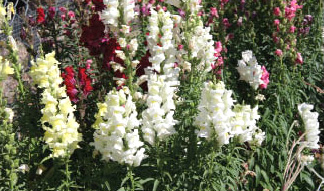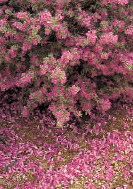
![]() chapter THREE
chapter THREE ![]()
Success with Desert Plants
Gardening with Annuals
The vibrant colors of flowering annuals, lined up in containers, pots and packs at the nursery, tempt us each spring and fall. Each variety of these bedding plants, as they are called, looks appealing and we want to take all of them home to add to our gardens. But it’s a good idea to design and prepare planting beds before purchasing plants. Keep in mind that most annuals are high-water-use plants. For this reason, it’s a good idea to use them in up-close areas near patios or entries. Annuals are also excellent in containers.
Getting Ready to Plant
Planting at the right season can be the difference between success or failure. Ideal times to plant winter- and spring-blooming annuals are when night air temperatures range between 40°F to 60°F, and daytime air temperatures are 60°F to 80°F. Daytime soil temperatures should be about 75°F. These conditions generally occur from mid-October through November.
Add organic soil additives to planting beds and mix thoroughly to 6 inches deep. Do this several weeks before planting. Bypass this step for desert natives. Moisten beds to 12 inches deep.
New plantings can quickly become stressed if winds are strong or temperatures rise suddenly. Be aware of the weather and water new plants carefully. In fast-draining, sandy soil, moisture must be supplied regularly for plants to grow and remain healthy. Neglect will cause hardening of tissues and loss of plant health or life. Check the soil often to determine if plants need water.
Soil-borne organisms have plagued new plantings of petunias and vincas when they have been planted in the same location, year after year. Prevent by removing leaf debris from planting beds, discard dead or dying plants and keep plants growing vigorously at all times. Rotate plantings—don’t always grow the same kind of plant in the same bed. Try something new each planting season. Contact your nursery for current disease controls.
Planting Wildflowers
Many wildflowers are included in the Annuals charts. Including wildflowers in your landscape takes a little planning, but is worth the effort. Follow these few simple guidelines for preparation and planting.
In order of preference, fall, winter and early spring are suitable for sowing seed of spring-blooming species. Plant summer-flowering varieties during the spring.
Almost any sunny location (at least six hours of sun each day) is a candidate for wildflowers. Wildflowers native to the desert are, by their nature, better equipped to cope with our climate and soil conditions than water-demanding species introduced from other regions. However, like other plants, even tough desert natives require regular moisture to germinate seeds and establish seedlings.
Wildflower mixes adapted to grow in the low desert are available for Coachella Valley gardeners. Individual species also work well. It is a matter of preference as to what effect you are looking for. If you create your own combination, select wildflowers that bloom at the same time. Consider planting them in separate beds to create distinct bands of colors. Over time, wildflower plantings take on their own character as plants reseed, spread and reseed some more.
Sow seeds for spring-blooming annuals in the fall. Seed mixtures typically contain six or more species to ensure a long season and a variety of color. A 1-ounce seed packet will cover approximately 500 square feet.
Prepare the planting area by removing weeds and debris prior to cultivation. Rake lightly to create a seed bed. Soak the soil slowly to moisten 8 to 12 inches deep.
Broadcast seeds with a hand-held fertilizer spreader or by hand. Most wildflower seeds are very small. Mixing with fine dry sand provides more even distribution, and allows you to see where seeds are being applied. Don’t plant seeds too deep. Most wildflowers do best with 1/8-inch coverage of soil, but read the seed package to be sure.
After seeding, rake soil lightly in a criss-cross pattern to cover seeds. Water lightly with a fine mist attachment on the hose. Avoid washing soil or applying so much water at one time that it creates gullies and runoff. Water seeded areas regularly until seedlings appear. After seeds sprout, apply water a couple of times each week, depending on moisture content of soil. Pull weeds as they appear.
Adding fertilizer is seldom necessary. Most desert wildflowers do well in soils having low fertility.
Germination periods vary considerably for different wildflowers, and are affected by soil and air temperatures. Some may sprout in two weeks, others take four to six weeks. Adequate deep moisture is essential.
After plants complete their flowering cycle and go to seed, cut them back to about 6 inches high. With some wildflower species, you can collect seeds for next year’s planting. Some seeds will have been eaten by birds or otherwise lost. To ensure another season of color, reseed with about half as much as the original planting in the fall. Note that spring seeding for summer annuals will require more moisture compared to fall-seeded plants. Perennial species will usually continue into the following year.
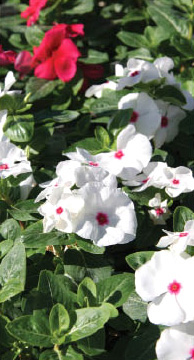
periwinkle |
||
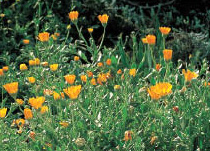 calendula |
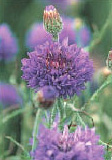
bachelor’s button |
|
| Botanical Name Common Name |
How to Grow Water, Sun, Temp. |
Description Mature Size Flowers Bloom Season |
||||
|---|---|---|---|---|---|---|
Ammi majus bishop’s flowers |
 |
|
This plant is similar in appearance to Queen Anne’s lace, growing to 3 feet high. White flowers bloom in summer, set off by finely dissected leaves that have toothed margins. Excellent cut flower. Plant in full sun in almost any soil. Easy to start from seed. | |||
Antirrhinum majus snapdragon |
 |
|
Tall, 1- to 1-1/2-foot “tetra” forms do best when staked early in their life to support stems. Dwarf types 6 to 18 inches high are ideal for massing and in borders. Colorful cut flowers. Plant mid-October to February. Plants bloom well into spring with regular water and monthly fertilizer. | |||
Calendula officinalis calendula |
 |
|
Flower colors range from bright yellows to deep orange, with best appearance in late winter and early spring. Growth is vigorous to 18 inches high. Long-lasting cut flowers. Plants tend to sprawl. Space 15 to 18 inches apart. | |||
Catharanthus roseus periwinkle vinca |
 |
|
(Vinca rosea). Profuse flowers from spring into summer, and often into fall. Many flower colors, including white, red, pink and magenta. Most selections grow 12 to 15 inches high but smaller forms are available. Plant in late spring. Feed with diluted liquid fertilizer monthly. | |||
Centaurea cyanus bachelor’s button |
 |
|
Grows to 2 feet high and almost as wide. Blooms from late spring to fall. The foliage is gray-green with blue, wine, rose, pink or white flowers at the end of the stems. Accepts full sun to partial shade. Reseeds easily. Grows in almost any soil. | |||
Cheiranthus cheiri wallflower |
 |
|
Grows to 2 feet high. Fragrant flowers bloom in shades of yellow and red. Plant in full sun and in soil with good drainage. Easy to grow from seed. Wallflower is rarely considered a wildflower but is added to wildflower mixes because it does well in meadows, favored for its bright colors. | |||
Chrysanthemum X morifolium chrysanthemum |
 |
|
This is the garden-variety chrysanthemum, also known as florist’s chrysanthemum. Plants may survive for years. They are available in a wide range of flower colors, growing 1 to 1-1/2 feet high. Accepts some shade. | |||
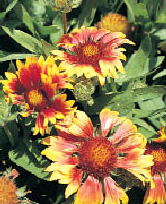 indian blanket |
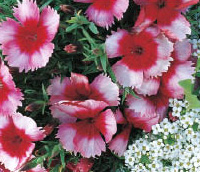
dianthus |
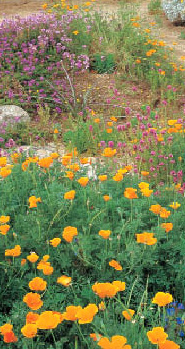
california poppy |
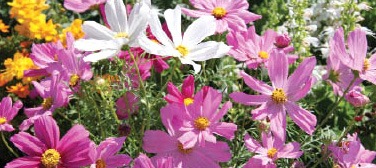
Cosmos |
||
| Botanical Name Common Name |
How to Grow Water, Sun, Temp. |
Description Mature Size Flowers Bloom Season |
||||
|---|---|---|---|---|---|---|
Clarkia amoena farewell-to-spring |
 |
|
This annual wildflower grows to 2 feet high with slender stems that support cup-shaped flowers in shades of pink, lavender or red. Several flowers often bloom on a single flowering stalk. Easy to grow from seed, but does not do well in humid climates when temperatures climb above 80°F. | |||
Collinsia heterophylla chinese houses |
 |
|
The name Chinese houses comes from the arrangement of the plant’s flowers, which look like miniature pagodas. Violet or white flowers bloom spring to early summer. Will grow to 2 feet high in full sun or partial shade. Tolerates most soil conditions. | |||
Cosmos bipinnatus cosmos |
 |
|
Open and airy color plant, with soft fernlike leaves and daisylike flowers in pink, red or white. Plant form is informal to 3 to 5 feet high so locate in the back of a natural border. Easy to grow from seed. Plant in moderately rich soil in full sun location in fall or early spring. | |||
Delphinium species larkspur |
 |
 |
|
A perennial that is treated as annual in the Coachella Valley. Blend one cup of bone meal into planting soil before planting. Position plant crown slightly above ground level so it will remain dry. Protect from heavy winds and add 4-foot stakes early on to support tall flower stems. | ||
Dianthus species dianthus |
 |
 |
|
Treat as an annual in the Coachella Valley. Colors range from white, pink, red, purple and shades between. Flowers have a delightful, spicy fragrance; enjoy in bouquets. Best in enriched, well-drained soil. Stake early to support tall flower stems. Accepts full sun to partial shade. | ||
Eschscholzia californica california poppy |
 |
|
California poppy is the state flower of California. Orange to yellow, cup-shaped flowers bloom on 12- to 18-inch stems from spring into early summer. Plants reseed readily. Sow seed where you want plants to grow. Does not like soil that is continuously moist or overly rich. | |||
Gaillardia pulchella indian blanket |
 |
|
Often used in western region wildflower seed mixes for its aggressive growth. Plants grow to 1-1/2 to 2 feet high. Long slender stems are topped with 2-inch red, yellow and gold flowers. Easy to grow from seed. Plant in soil with good drainage. Blooms from midsummer to frost. | |||
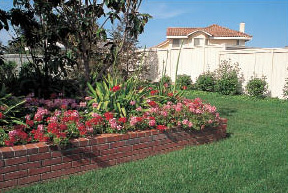
Geranium |
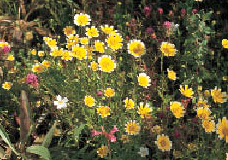
tidy tips |
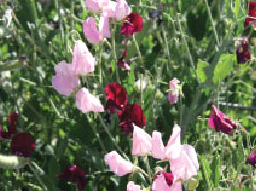
sweet pea |
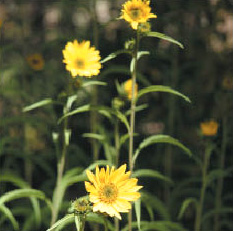
Maximilian Sunflower |
| Botanical Name Common Name |
How to Grow Water, Sun, Temp. |
Description Mature Size Flowers Bloom Season |
||||
|---|---|---|---|---|---|---|
Geranium species geranium |
 |
 |
|
Geraniums are treated as annuals in low-elevation desert regions and are ideal container color plants. Accepts full sun or partial shade but requires well-drained soil. Enjoy the spring flowers then move containers into shade as the warm season comes on in late April and May. | ||
Gilia capitata blue thimble flower |
 |
 |
|
Plants grow to 2 feet high with tall, slender stems. Blue pin-cushion flowers bloom from summer to fall. Leaves to 4 inches long are finely dissected, adding a light airy feeling to plants. Accepts full sun to partial shade. Easy to grow from seed. Sow in place in early spring. | ||
Helianthus maximilianii Maximilian Sunflower |
 |
|
A perennial grown as an annual in the Coachella Valley. Tall flower stalks to 6 feet high or more are topped with familiar sunflower flowers in fall. Place at back of border due to plant height. Accepts some shade and most soil conditions. Birds love the seeds. | |||
Lasthenia glabrata goldfields |
 |
|
An annual wildflower that grows 6 to 24 inches high. Slender stems are topped with small yellow flowers from spring into summer. Excellent for fast temporary cover and color. Often included in western wildflower mixes; competes well with grasses. Use for revegetation and stabilization. | |||
Lathyrus odoratus sweet pea |
 |
|
Sweet peas are available in a wide range of colors. Blooms late winter through spring. Dwarf types excel in flower borders or in planters. If you start with seeds, soak them in water for several hours before planting. Plant in well-prepared soil, and provide supports for plants to climb. | |||
Layia platyglossa tidy tips |
 |
|
Wildflower annual with yellow daisylike flowers tipped with white. They are 1 to 2 inches across and showy, blooming on plants to 1 foot high. Flowering begins in early spring and can last for several months. Grows best in well-drained soil in full sun or partial shade. | |||
Linaria maroccana toadflax |
 |
 |
|
An annual wildflower growing 1 to 2 feet high. Flowers in mixed colors look like snapdragons. Blooms spring to summer. Grows easily from seed. Prefers light shade. For best show of color, sow seed in large quantities. Reseeds to come back the following spring. | ||
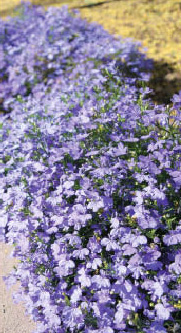
lobelia |
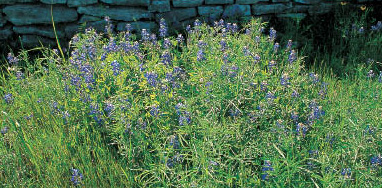
texas bluebonnet |
|
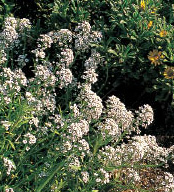
sweet alyssum |
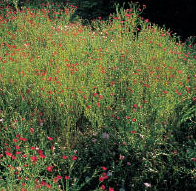
scarlet flax |
|
| Botanical Name Common Name |
How to Grow Water, Sun, Temp. |
Description Mature Size Flowers Bloom Season |
||||
|---|---|---|---|---|---|---|
Linum grandiflorum ‘Rubrum’ scarlet flax |
 |
 |
|
This annual wildflower grows rapidly 1 to 1-1/2 feet high, producing brilliant, scarlet flowers at ends of tall stems. Plant in well-drained soil in fall; it will not tolerate soggy soil during the cool season. Accepts full sun to partial shade. Blooms from spring into midsummer. Reseeds readily. | ||
Linum perenne subsp. lewisii blue flax |
 |
 |
|
This annual wildflower produces a breathtaking bouquet of dazzling, sky-blue flowers that have a satiny sheen. They open every morning then fade in the afternoon heat. Plants grow to 2 feet high with a light, airy, vase shape that allows them to blend well with other wildflowers. | ||
Lobelia erinus lobelia |
 |
|
Popular and dependable border plant or cover for bulbs, grown for late winter and spring bloom. Flowers are usually light blue to violet with contrasting throats in white or yellow. Grows 6 to 8 inches high. Plant in rich, improved soil. Can reseed with good growing conditions. | |||
Lobularia maritima sweet alyssum |
 |
|
An easy-care annual that is an excellent companion to bright-colored annuals or perennials. Grows 6 to 8 inches high in white, rose or purple. Easy to grow from seed or set out plants from packs fall to early spring. Locate in sun to partial shade. Cold hardy. | |||
Lupinus densiflorus var. aureus golden lupine |
 |
|
An annual wildflower native to California. Showy, spiked, pealike, golden flowers stand high above the leaves, blooming early spring to early summer. Plants grow to 2 feet high. Sow seed in full sun in fall for flowers the following spring. Prefers well-drained soil. | |||
Lupinus texensis texas bluebonnet |
 |
|
This annual wildflower is the state flower of Texas, and announces spring with sweeping masses of blue-plumed flowers along roadsides and in meadows. Plants grow 1 to 2 feet high. Germination can be sporadic but may be increased by purchasing scarified (scratched) seed. | |||
Matthiola incana stock |
 |
 |
|
A dependable garden annual featuring fragrant flowers in a range of colors. Grows 1-1/2 to 2 feet high with an equal spread late winter to early spring. Makes a fine background for smaller annuals. Plant in well-drained soil improved with amendments in full sun to partial shade. | ||
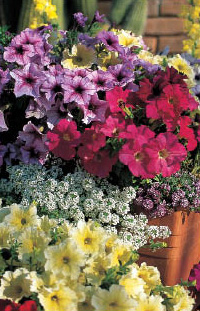
petunia |
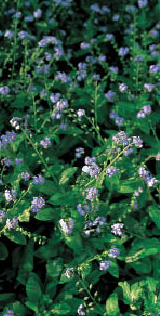
forget-me-not |
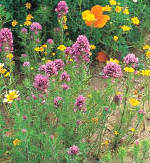
owl’s clover |
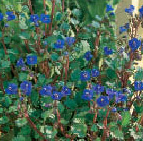
california bluebell |
| Botanical Name Common Name |
How to Grow Water, Sun, Temp. |
Description Mature Size Flowers Bloom Season |
||||
|---|---|---|---|---|---|---|
Myosotis sylvatica forget-me-not |
 |
|
This annual produces numerous, small, blue or sometimes pink flowers that bloom in spring. Plants grow 6 to 15 inches high. Prefers regular moisture and slightly acid to neutral soil. Accepts full sun to light shade. Easy to grow from seed. | |||
Nemophila maculata five spot |
 |
|
Flowers of this wildflower are the same as baby blue eyes, below, but are white with vivid purple spots at the tip of each petal. Grows to just 6 inches high, spreading 12 inches or more wide. Accepts most soils, including heavy clay or sand. Attractive when planted in drifts. | |||
Nemophila menziesii baby blue eyes |
 |
 |
|
This wildflower grows 6 to 10 inches high with delicate, sky blue flowers marked with white spots. Best with moderate water in shaded areas. Avoid planting in hot or humid conditions. Start from seed either in spring or fall. A prolific bloomer that will reseed itself. | ||
Orthocarpus purpurascens owl’s clover |
 |
|
Reliable wildflower for fast cover and color from early spring into summer. Suited to a natural border or in a wildflower mix. Grows to 8 inches high with rose-pink to purple, plumelike flowers that resemble clover. Sow seed in early fall in full sun to partial shade location. Reseeds well. | |||
Papaver rhoeas flanders field poppy |
 |
|
Large, showy flowers in many bright colors on plants 2 to 4 feet high. Provide light, well-drained soil, moderate water in a full sun to partial shade location. Prefers open areas and competes well with grasses. Sow seeds in fall or early spring. | |||
Petunia hybrids petunia |
 |
|
Petunias are the most colorful of all annuals in desert gardens, and are available in a wide range of forms and flower colors. Prefers sun but accepts partial shade. Mix pellet-type fertilizer into soil when planting. Check soil moisture often; overwatering can lead to disease problems. | |||
Phacelia campanularia california bluebell |
 |
|
Prolific-blooming wildflower with rich blue, bell-shaped flowers in early spring to early summer. Plants grow 6 to 18 inches high with lush-looking, dark green, fragrant, heart-shaped leaves. Accepts most soils but performs best in rocky soils with good drainage. Reseeds itself. | |||
Phlox drummondii Annual phlox |
 |
|
Low growing, to 6 to 12 inches. Best planted in a mass or in a color border. Soft flower colors come in mostly shades of salmon, pink, yellow and white. Accepts full sun to partial shade. Plants and flowers hold up well to late spring and early summer heat. Reseeds well. | |||
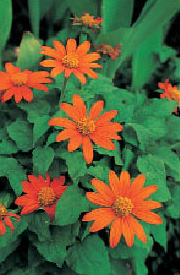
Mexican Sunflower |
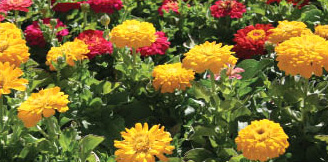
zinnia |
|
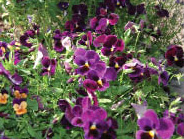
viola |
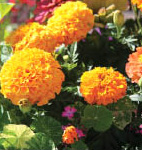
marigold |
|
| Botanical Name Common Name |
How to Grow Water, Sun, Temp. |
Description Mature Size Flowers Bloom Season |
||||
|---|---|---|---|---|---|---|
Primula malacoides fairy primrose |
 |
|
Adds splashes of color in shaded or partially shaded locations. Delicate-textured leaves are pale green, oval, to 3 inches long. They grow in rosettes close to ground. Vertical flower stems 8 to 10 inches high bloom in spring in shades of white, pink, red and mauve. Best in improved soil. | |||
Silene armeria catchfly |
 |
|
Summer-blooming wildflower, when most annual wildflowers are well past their peak. Pink to lavender flowers are borne in tight clusters on small bushy plants to 2 feet high. The individual flower petals are deeply notched. Accepts full sun to partial shade in almost any soil. | |||
Tagetes erecta marigold |
 |
 |
|
Valuable summer color plants. Select from a wide range of flower forms in yellows and oranges. Dwarf, 8- to 12-inch types are ideal in borders; taller 18-inch varieties look best behind low border shrubs. Keep plants growing continuously with regular water and fertilizer. | ||
Tithonia rotundifolia Mexican Sunflower |
 |
|
Grows up to 6 feet high and to 3 feet wide. Large, orange or yellow sunflower blooms put on a show from midsummer until frost. Like Maximillian sunflower, use in back of the border. Attracts hummingbirds and swallowtail butterflies. | |||
Verbena hybrids verbena |
 |
|
Colorful annual border plants, growing from 8 to 12 inches high. Available in a range of flower colors, including white, red, pink, blue and purple. After flowering, trim spent blooms for regrowth. Plant in fall to enjoy late winter-spring flowers. | |||
Viola cornuta viola |
 |
|
At home as a low, 6- to 9-inch border along walks, in front of mixed plantings and in containers. Flowers come in white, blue, yellow and apricot. Does well in sunny to partially shaded locations. Flowers profusely until heat arrives in late spring. Accepts temperatures as low as 28°F. | |||
Viola X wittrockiana pansy |
 |
|
Reliable annual for winter and spring color. Many selections are available in a wide range of flower colors. Grows 6 to 8 inches high. Best in a warm microclimate. Enrich soil with blood meal before planting and feed monthly. Cut back plants lightly March to April to renew growth. | |||
Zinnia elegans zinnia |
 |
|
One of the best annuals for summer color. Flowers come in a range of bright colors, and are large—up to 6 inches across. Dwarf types grow as low as 6 inches; taller types can be as much as 3 feet high. ‘Profusion’ series grow 1-1/2 to 2 feet high. Flood-irrigate or use drip irrigation. | |||
